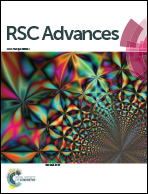Smartphone based LSPR sensing platform for bio-conjugation detection and quantification†
Abstract
We report here the working of a localized surface plasmon resonance (LSPR) sensor using the camera of a smartphone. Integrating light weight and simple laboratory optical components with the camera module of the phone, we first designed a visible spectrophotometer with a pixel resolution of 0.336 nm per pixel. The LSPR peak absorption wavelength shift due to size variation of gold nanoparticles (AuNPs) and analyte (protein and enzyme) conjugation with AuNPs have been successfully recorded by our smartphone spectrophotometer. The shift in LSPR peak absorption wavelength can be correlated with the size of the AuNPs and concentration of biomolecules attached to it. The limit of detection (LOD) of the designed sensor for quantification of BSA protein and trypsin enzyme was estimated to be 19.2 μg mL−1 (equivalent to 0.28 μM) and 25.7 μg mL−1 (equivalent to 1.10 μM) respectively. We compare the results with a laboratory grade standard UV-VIS spectrophotometer and observe high reliability of our designed sensor. Owing to its compact size, simple optics design and involvement of low-cost optical components we envision that the proposed sensing system could emerge as an alternative inexpensive handheld LSPR sensing tool that can be suitable for different in-field applications.


 Please wait while we load your content...
Please wait while we load your content...